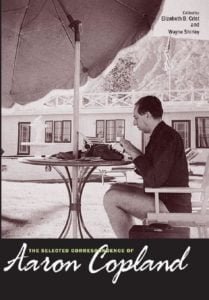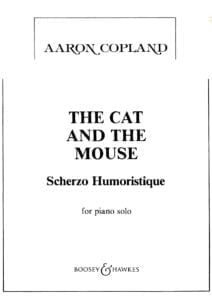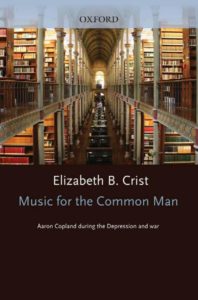- Aaron Copland: the 100 most inspiring musicians of all time
- Aaron Copland’s sheet music download here.
- Copland Plays Copland Piano Concerto
Browse in the Library:
and subscribe to our social channels for news and music updates:
Aaron Copland: the 100 most inspiring musicians of all time
American composer Aaron Copland (b. Nov. 14, 1900, Brooklyn, N.Y., U.S.—d. Dec. 2, 1990, North Tarrytown [now Sleepy Hollow], N.Y.) achieved a distinctive musical characterization of American themes in an expressive modern style.

Copland, the son of Russian-Jewish immigrants, was born in New York City and attended public schools there. An older sister taught him to play the piano, and by the time he was 15 he had decided to become a composer. In the summer of 1921 Copland attended the newly founded
school for Americans at Fontainebleau, where he came under the influence of Nadia Boulanger, a brilliant teacher who shaped the outlook of an entire generation of American musicians. He decided to stay on in Paris, where he became Boulanger’s first American student in composition.
After three years in Paris, Copland returned to New York City with an important commission: Nadia Boulanger had asked him to write an organ concerto for her American appearances. Copland composed the piece while working as the pianist of a hotel trio at a summer resort in Pennsylvania. That season the Symphony for Organ and Orchestra had its premiere in Carnegie Hall with the New York Symphony.
In his growth as a composer Copland mirrored the important trends of his time. After his return from Paris, he worked with jazz rhythms in Music for the Theater (1925) and the Piano Concerto (1926). There followed a period during which he was strongly influenced by Igor Stravinsky’s
neoclassicism, turning toward an abstract style he described as “more spare in sonority, more lean in texture.” This outlook prevailed in the Piano Variations (1930), Short Symphony (1933), and Statements for Orchestra (1933–35). After this last work, there occurred a change of direction that was to usher in the most productive phase of Copland’s career.

He realized that a new public for modern music was being created by the new media of radio, phonograph, and film scores: “It made no sense to ignore them and to continue writing as if they did not exist. I felt that it was worth the effort to see if I couldn’t say what I had to say in the
simplest possible terms.” Copland therefore was led to what became a most significant development after the 1930s: the attempt to simplify the new music in order that it would have meaning for a large public.
The decade that followed saw the production of the scores that spread Copland’s fame throughout the world. Most important of these were the three ballets based on American folk material: Billy the Kid (1938), Rodeo (1942), and Appalachian Spring (1944; commissioned by dancer Martha Graham). To this group belonged also El salón México (1936), an orchestral piece based on Mexican melodies and rhythms; two works for high-school students—the “play opera” The Second Hurricane (1937) and An Outdoor Overture (1938); and a series of film scores, of which the best known are Of Mice and Men (1939), Our Town (1940), The Red Pony
(1948), and The Heiress (1948).
Typical too of the Copland style are two major works that were written in time of war— Lincoln Portrait (1942), for speaker and chorus, on a text
drawn from Lincoln’s speeches, and Letter from Home (1944), as well as the melodious Third Symphony (1946).
In his later years, Copland refined his treatment of Americana: “I no longer feel the need of seeking out conscious Americanism. Because we live here and work here, we can be certain that when our music is mature it will also be American in quality.” His later works include an opera, The Tender Land (1954); Twelve Poems of Emily Dickinson (1950), for voice and piano; and the delightful Nonet (1960).
During these years, Copland also produced a number of works in which he showed himself increasingly receptive to the serial techniques of the so-called 12-tone school of composer Arnold Schoenberg. Notable among such works are the stark and dissonant Piano Fantasy (1957); Connotations (1962), which was commissioned for the opening of Lincoln Center for the Performing Arts in New York City; and Inscape (1967). The 12-tone works were not generally well received; after 1970 Copland virtually stopped composing, though he continued to lecture and to conduct through the mid-1980s.

For the better part of four decades, as composer (of operas, ballets, orchestral music, band music, chamber music, choral music, and film scores), teacher, writer of books and articles on music, organizer of musical events, and a much sought-after conductor, Copland expressed “the deepest reactions of the American consciousness to the American scene.”
He received more than 30 honorary degrees and many additional awards. He also wrote a number of books on music. A private man not given to making public statements about his personal life, Copland nonetheless made no efforts to hide his homosexuality, traveling openly with younger lovers. And though blacklisted during the McCarthy era, the government-led censure had no lasting effect on Copland’s work and career.
Aaron Copland’s sheet music download here.
Copland Plays Copland Piano Concerto
- 1. Andante sostenuto
- 2. Molto moderato – Allegro assai
New York Philharmonic Young People’s Concert, Jazz in the Concert Hall Recorded February 8, 1964.